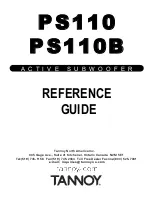
6
Amplifier Controls and Setup
(continued)
4. Auto Signal Tracking:
The subwoofer amplifier uses “smart” signal tracking circuitry. Once
the power cord is plugged in and the switch set to auto, the amplifier automatically turns on
when a signal is detected at the preamplifier or high level inputs and turns off when no signal
has been detected for 15 minutes.
5. Phase Control:
This control changes the phase of the subwoofer. Changing the phase
will change the way the subwoofer and main speakers interact with each other at the
crossover frequency. Varying the phase position may result in more or less mid bass
depending on the phasing between the main speakers and the subwoofer. Generally,
the phase is left at the 0° position.
6. Low-pass Switch:
This switch allows the amplifiers internal crossover to be defeated
when using an external crossover, or when the crossover is not needed. This switch
should be in the “on” position when the audio signal sent to the subwoofer is not from
a previously crossed-over source. The switch should be set to “off” when the audio
signal sent to the subwoofer is coming from a source already using a crossover, such as
the subwoofer pre-out from a receiver or pre-amplifier. This will ensure the subwoofer
is not receiving an audio signal which is double-filtered.
NOTE:
Read the Important Notice on page 3 regarding bass management.
7. Line Output:
These RCA terminals are for “daisy chaining” to another subwoofer or
amplifier. A full-range signal is sent through these terminals.
8. LFE Line Level Input:
Typically this will be the line level input used to connect to most
receivers or processors. The LFE input will bypass the subwoofer’s crossover control. This
input should be used when the input signal is coming from a receiver or processor where
the bass management is controlled by the receiver or processor.
NOTE:
Read the Important Notice on page 3 regarding bass management.
9. High/Speaker Level Input:
These binding post terminal connections are for the
amplifier/speaker level input from an amplifier or receiver.
IMPORTANT! Use either the Line Input or the High Level Input. DO NOT use them both
simultaneously.
10. High Level/Speaker Output:
This is a 100 Hz high-passed output for your satellite/main
speakers. The crossover limits the low frequencies (below 100 Hz) from going to your
satellite/main speakers. This crossover is active only when using the High Level Input
terminals. Connect your main speakers (observing the proper polarity) to these terminals
when using the High Level Inputs.
11. Fuse Access:
This is the power fuse access.
WARNING! In the event the fuse must be replaced, the replacement fuse must match
exactly the original fuse value. If the replacement fuse is not of the same value, damage
to the Subwoofer Amplifier may result.
CAUTION! Before replacing the fuse, disconnect the power cord from the power
receptacle.
Содержание subwoofer
Страница 1: ...SUBWOOFER O w n e r s M a n u a l...
Страница 2: ......
Страница 9: ...CT Series Amplifier Diagram 7 CT Series Amplifiers MS 8 1 and MS 10 1...


































